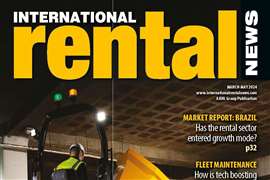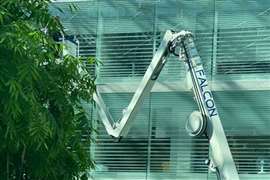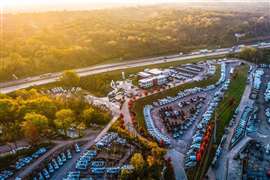Branching out
17 April 2008

Terex has come a long way from its near extinction in the early 1990s to establish itself as no.3 in the global equipment market. But according to president and COO Tom Riordan, there is more to come, as it plans new factories and eyes new markets. Chris Sleight reports.
Terex has had more ups and downs over its long history than most companies in the construction equipment industry, but is definitely enjoying an ‘up' at the moment.
From being on the edge of bankruptcy in the early 1990s, it acquired itself out of trouble, buying a string of struggling manufacturers and turning them around. Although it has bought some 40 companies since starting with ailing crane manufacturers like Koehring and PPM in the mid-1990s, it was the acquisition of German crane giant Demag and US access platform maker Genie in 2002 that catapulted it into the industry's major league.
Not only were these major acquisitions in terms of their size, adding significantly to the company's revenues, but they also brought credibility to the company because they were leaders in their niches, rather than being ‘damaged goods'.
These acquisitions and the last five years' boom in demand for construction equipment have seen Terex establish itself as no.3 in the global construction industry behind Caterpillar and Komatsu. Its financial results were due as iC went to press, but revenues for last year are expected to come in at around US$ 9 billion.
China
Certainly the company has come a long way, but at the same time it is not the finished article. One of the areas it is relatively weak is China. Despite its involvement in North Hauler, a long-standing joint venture in Baotou, Inner Mongolia producing off-highway trucks, Terex is a relative newcomer to the market.
Starting from a low base, its growth has been impressive - "The Chinese market continues to be very strong for us. Our revenues for 2007 were up more than 100% form the previous year," said president and chief operating officer (COO) Tom Riordan. However, its revenues in China remain relatively low, at US$ 380 million in 2007.
But Mr Riordan sees this as an opportunity rather than a weakness. "We are in a very interesting position. We have a very broad line of products, strong product development capabilities, and we're at a very early stage in terms of developing our business here in China.
"Our preference is to find strong local patterns that we can prosper and grow together with. That is evident in the way we got involved in China 20 years ago with a joint venture (North Hauler) that is still in place today. But if we're not able to find the right kind of partnership, we have the ability to grow the business on our own," he said.
Recent years have seen Terex start to build compact excavators in small factories in Sanhe and Tianjin in north eastern China, and take a minority interest in Atlas Construction Machinery Company (ACMC) a joint-venture building medium-sized excavators. April 2006 saw it acquire a 50% stake in Changjiang Crane, a company manufacturing on-highway truck cranes from its headquarters in Luzhou, Sichuan Province.
Genie, Terex's access platform and telescopic handler business could be the next part of the company to benefit from a plant in China. Tim Ford, president of Terex Aerial Work Platforms has said he would like to see a Genie factory up and running in Asia-Pacific by 2009, and China seems the most obvious choice.
It sounds like a tight timescale, but Mr Riordan was confident it could be achieved. "It takes a while to get a factory up and running, but what never ceases to amaze me, particularly in China, is how quickly things can move. Having been involved in this region for a number of years, I know that having a plant building up within 6 months is very feasible. The challenge is putting in assembly lines and putting in the talent to run the business," he said.
"We have a number of plans that we've not yet announced, but which will add additional capacity and products in the market place to satisfy the aggressive growth in Chinese consumption," Mr Riordan added.
Balance
One of the reasons for the focus on China - apart from the obvious benefits of a booming market - is Terex's desire diversify where it gets its revenues from. At the moment it is heavily dependent on Europe and the US, with relatively few sales elsewhere in the world.
"Terex will be stronger in Asia, particularly in China. Longer-term we would expect, as opposed to 40% of our revenues from the US and 60% outside the US, to have much better balance. That would be one-third of our sales in North America, one third in Europe, and one third in the rest of the world, with a particular focus on Asia-Pacific," said Mr Riordan.
One of the problems Terex has at the moment is that the regions where it builds its equipment are not as well matched as they could be to where it sells them (or would like to sell them). A particular issue is its Construction division, which encompasses earthmoving equipment from mini excavators and backhoe loaders up to larger wheeled loaders, excavators and haulers.
Pretty much all of these machines are built in Europe, and the slide in value of the US Dollar over the last six years or so has been a barrier to selling these equipment types in North America. As Mr Riordan said, "When the exchange rate was € 0.9 to the Dollar that looked brilliant, now the rate is € 1.5, it doesn't look so good."
Despite the current difficulties in the US market, the company is planning to expand its footprint in North America to help address this imbalance.
"The challenge in the US and North America is to find the right kind of plant capacity and products. We're comfortable with our strategy, but over the next 24 months we need to embark upon a significant build-out of our manufacturing capability in North America - maybe in the US, maybe in Mexico - but we feel we have to be in those markets if we're going to truly participate in them."
"We believe that it is likely to be approximately two years before the broader construction equipment industry significantly picks up. As a result, we've given ourselves a few years to put the infrastructure in place in the US market to move away from the very strong dependence we have on European manufacturing today," he said.
Acquisitions?
Considering that Terex got where it is today through acquisitions it is interesting that Mr Riordan puts so much emphasis on organic growth. Expanding factories and building new ones is the company's answer to diversification. Does that mean big acquisitions are off the menu?
"I think what you'll find today in a strong market is that valuations of companies are very high, and it's difficult to find acquisitions that make economic sense. As business tempers, you'll see decreased valuations and continuous changes in this historically volatile and cyclical industry. Those tend to be times that create opportunity for acquisition.
"There is a lot of interest on our part for acquisitions, but they need to be for the right purpose - new products, new technologies, new geographies, new customers and new channels to market, as opposed to buy a company that's struggling and which doesn't do much for Terex strategically.
"We're much more in a strategic acquisition mode than the opportunistic mode," said Mr Riordan.
Since iC spoke to Mr Riordan, Terex has announced its agreement to buy ASV, a US-based manufacturer of tracked loaders, which fits the bill of bringing a new product into the fold. At a price of US$ 488 million - more than 20 times its net profits in 2006 and almost 40 times the best estimate for ASV's 2007 net profits - the deal is also a far cry from the late 1990s, when Terex was picking up companies almost for free because no-one else wanted them.
However, as a general comment, Mr Riordan said, "As our history shows, Terex has been a disciplined buyer of companies, and we will continue that, but for the right kind of companies, we're willing to pay full value to make them part of the Terex family."
Goals
Terex's overarching aim is, according to Mr Riordan, "To be US$ 12 billion in sales and 12% operating margins in 2010." He added, "I think it's a bit of a stretch for it to happen organically, but we're not counting on acquisitions. Our belief is if they happen, that's great."
The company clearly has a plan to achieve this - by increasing its presence in parts of the world where it is weak and by producing machines on a more regional, rather than global basis. But like many companies in all walks of the construction industry, skills shortages remain a problem for Terex.
"Our biggest restraint on growth today is talent. Our biggest talent is finding the right kind of ability and leadership to recruit into the company to help us grow," concluded Mr Riordan.
==== BOX STORY ====
Market view
Tom Riordan looks at the global equipment markets
"The Chinese market continues to be very strong for us. Our revenues for 2007 were up more than 100% form the previous year. The other countries in the Asia-Pacific region, specifically Thailand and Vietnam, are exhibiting strong growth. Australia is a good market for us, based on the mining activity down there."
"There is a dichotomy in Europe between Eastern and Western Europe. Western Europe is exhibiting solid growth, but Eastern Europe is growing significantly quicker, and quicker than we had expected. Using our loader backhoes as n example, our business in Western Europe was up +28% over the last two years, yet in Eastern Europe it was up approximately +235%. So there's significant difference in growth."
"The US is soft, which is not a surprise. While one of our competitors is suggesting the US is in recession, we don't quite see it that way, but revenues are down mid-teen percentages. In spite of that, based on demand in the rest of the world, we are able to offset that drop in revenue in the US with significant growth elsewhere.
"In a large part we expect those trends to continue. We expect the US to be down a little bit - soft is probably the best description. We think Europe will continue to show solid growth, and frankly everywhere else, particularly in China, we see very aggressive growth rates."
==== USE WITH HEAD & SHOULDERS CROP FROM LEAD PIC ====
==== box story ====
Battling the backlogs
Terex is trying to reduce lead times, particularly for cranes
All manufacturers in all parts of the construction industry have had to deal with lengthening order backlogs over the last five years, as demand for construction equipment has shot up around the world.
Industries using particularly heavy equipment - mine operators and lifting contractors - have been among the worst affected, and Terex readily admits that lead times for its cranes are too long.
"We've got a very strong business that we think is going to continue for a long time to come. But backlogs are extending, which is never good for customers. Our concern is how we get backlogs back to reasonable levels - we've got products that are unfortunately booking orders in 2010 already," said Mr Riordan.
He continued, "We haven't announced any specific new plant plans. One of the things we're very much focused on is the application of lean tools - what call the Terex Business System - into our different facilities as it relates to assembly capacity, welding fabrication, machining and so on.
"One of the things we found is that with the use of some analysis tools, some of them very simple tools, you can significantly change the output of the plant. Take welding torches as an example - you want to make sure they're burning more, and that people aren't wasting time looking for parts or looking for a supervisor, which is a waste of time in terms of throughput.
"Our Demag business, which is a very significant part of our cranes business, is busting at the seams. There are a lot of capacity constraints despite the capital we've put in over the last couple of years. We‘re looking at a significant expansion in facilities with that business - potentially putting some manufacturing capability here in China."
As well as the constraints of its own factories, Terex, like everyone else in the industry, has had to contend with a lack of crucial components such as bearings, tyres and hydraulic systems, and this to is an area Mr Riordan says Terex is working on.
"We've spent a lot of time on improving our internal planning processes and spending a lot of time on our supply base. For example, our cranes business has got over 20 people who, for most of the last six months, have been dedicated to supplier production and quality management, who were not in place a year ago," he said.







